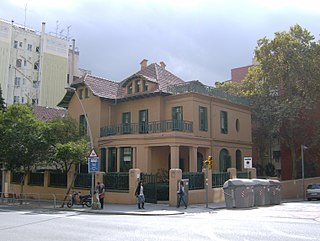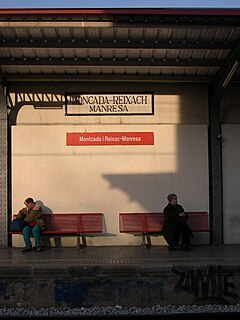
The Barcelona Metro is an extensive network of rapid transit electrified railway lines that run mostly underground in central Barcelona and into the city's suburbs. It is part of the larger public transport system of Barcelona, the capital of Catalonia, Spain with unified fares under the Autoritat del Transport Metropolità (ATM) scheme. As of 2014, the network is operated by two separate companies: Transports Metropolitans de Barcelona (TMB) and Ferrocarrils de la Generalitat de Catalunya (FGC). It is made up of 12 lines, combining the lines owned by the two companies. Two lines, L9 and L10 are being built at present, with both lines having different sections of each opened between 2009 and 2016. They are due to be fully completed in 2026. Three lines on the network have opened as automatic train operation/driverless vehicle systems since 2009: Line 11, Line 9 and Line 10, in chronological order. The network length is 166 kilometres, with 189 stations, as of June 2019.

The Trambaix is one of Barcelona's three tram systems. It is operated by TRAMMET connecting the Baix Llobregat area with the city of Barcelona, Catalonia, Spain. It opened to the public on 5 April 2004 after a weekend when the tram could be used free of charge.

Trambesòs is a tram–light rail system in the Spanish autonomous community of Catalonia that links the Barcelona district of Sant Martí with Badalona and Sant Adrià de Besòs. Its name comes from the union of the words "tram", an abbreviation of the Catalan word for "tram" (tramvia), and "Besòs", the name of an area in the north of the Barcelonès region dominated by the Besòs River.
— Line 8, coloured pink and operated by FGC, is part of the Barcelona Metro network, and therefore of the larger ATM fare-integrated transport system. It joins Plaça Espanya, in the Sants-Montjuïc district of Barcelona with metropolitan area municipalities of L'Hospitalet de Llobregat, Cornellà de Llobregat and Sant Boi de Llobregat.

The Metropolitan Transport Authority is a public consortium intended to coordinate the operation and project the expansion of the public transport system in the Barcelona metropolitan area. It is made up of the Government of Catalonia and local administrations. It has been known as ATM Àrea de Barcelona since 2003 to differentiate it from the other existing Catalan public transport authorities in the Girona, Camp de Tarragona and Lleida areas, which are also identified as ATM. As of January 2015, the ATM-managed public transport system comprises 50 different operating companies and serves 346 municipalities, accounting for a population of over 5.7 million.

Tenerife Tram is a light rail or tram service located on the island of Tenerife, one of the Canary Islands (Spain). It is operated by Metropolitano de Tenerife, a limited company now 100% owned by the Cabildo of Tenerife. Service started on 2 June 2007 over a 12.5-kilometre (7.8 mi) route which linked the Intercambiador in Santa Cruz de Tenerife with Avenida de la Trinidad in La Laguna. A second line between La Cuesta and Tíncer opened in 2009. It is the only existing tramway or train in the Canary Islands.

Avinguda Diagonal is the name of one of Barcelona's broadest and most important avenues. It cuts the city in two, diagonally with respect to the grid pattern of the surrounding streets, hence the name.

Plaça de les Glòries Catalanes, most often shortened to Glòries, is a large square in Barcelona, first designed by Ildefons Cerdà to serve as the city centre in his original urban plan, but nowadays relegated to quite a secondary position. It is located in the Sant Martí district, bordering Eixample, at the junction of three of the city's most important thoroughfares: Avinguda Diagonal, Avinguda Meridiana and Gran Via de les Corts Catalanes. Currently it serves largely as a roundabout of elevated highways. However, beginning in the early 2000s, and as of 2007, revamping project for Glòries has started, which is aimed to give the square a new role in Barcelona and revitalize the northern districts of the city, under the name 22@. These plans supplement other large-scale plans in Sagrera and the Fòrum area. The first installment of this project was the construction of the controversial Torre Agbar skyscraper.

Zona Universitària is a station in the Barcelona Metro and Trambaix networks, in the Les Corts district of Barcelona. It is currently the western terminus of metro line L3 and L9. Also it's served by tram lines T1, T2 and T3. It is named after the Universitat de Barcelona campus of the same name.

Palau Reial is a station in the Barcelona Metro and Trambaix networks, in the Les Corts district of Barcelona. It is served by metro line L3 and tram lines T1, T2 and T3. The station draws its name from the nearby minor royal palace in Pedralbes built for Alfonso XIII in 1924, part of which nowadays hosts a Museum of Decorative Arts.

Gorg is a Barcelona Metro and Trambesòs complex named after the neighbourhood of the same name where the station is situated, in Badalona municipality. It is located on Avinguda del Marquès de Mont-Roig and very close to Palau Municipal d'Esports de Badalona, the home arena of the professional basketball club Joventut de Badalona. It is served by TMB-operated Barcelona Metro lines L2 and L10, and Trambesòs route T5.

The Tramvia Blau is one of Barcelona's three tram systems. It is a 1.276 kilometres (0.793 mi) long heritage streetcar line serving a hilly area of the Sarrià-Sant Gervasi district between the terminus of FGC Barcelona Metro L7 and the Funicular del Tibidabo.

Maria Cristina is a station in the Barcelona Metro and Trambaix networks, in the Les Corts district of Barcelona. It is served by metro line L3 and tram lines T1, T2 and T3.
Public transport in Barcelona is operated by several companies, most of which are part of the Autoritat del Transport Metropolità, a transport authority managing services in the Barcelonès and the rest of the metropolitan area of Barcelona. This article is a summary with transport facilities and services strictly within the municipality of Barcelona, and contains links to more specific articles.

Public transport in Cornellà de Llobregat is an important part of the transportation network spanning the Metropolitan Area of Barcelona. The city of Cornellà, a mostly working-class area with strong dormitory town traits, is one of the most populated in the Baix Llobregat with about 90,000 inhabitants and a daily destination for thousands of commuters in the urban area of the capital.

Public transport in Montcada i Reixac is a part of the transportation network in the Metropolitan Area of Barcelona. The town is located in a geographically strategic position, immediately to the north of Barcelona's Nou Barris district and surrounded by the hills of Collserola and the adjacent towns of Vallès, and contains a few train stations which articulate the rail transport in the urban region.
TramVallès, Tramvallès or Tramvia del Vallès is a proposed tram or light rail network in the metropolitan area of Barcelona. Its name stems from the region of Vallès, which spans two counties north of the Catalan capital. The region is densely populated, includes the Autonomous University of Barcelona and current public transport services are insufficient for commuters. Following expressions of citizen support, the Generalitat de Catalunya, the governing body of Catalonia, approved the project in 2010. Tramvallès would serve the following municipalities: Montcada i Reixac, Ripollet, Cerdanyola del Vallès, Badia del Vallès, Sant Cugat del Vallès, Barberà del Vallès, Sabadell and Terrassa.

The Madrid city of Parla has a circular tram which provides transportation within the city as well as to the rest of the metropolitan area. This network is standard gauge which facilitates compatibility and vehicle interchangeability with other lines built or planned in the Community of Madrid. The main shareholder of the company is Globalvia with 85%, and then CCM with 15%.

Historically, the city of Barcelona, in the Spanish autonomous community of Catalonia, had a large tramway network. The city's first tram line opened in 1872, but almost all of these historic lines had closed by 1971, being replaced by buses and by the expanding Barcelona Metro. The one remaining line, the Tramvia Blau, was retained as tourist attraction, utilising historic rolling stock. However at the beginning of the 21st century, two new tram systems, the Trambaix and Trambesòs, opened in the suburbs of the city.

Francesc Macià is a Trambaix station and a projected metro station located in the Plaça de Francesc Macià, Barcelona, crossed by the Avinguda Diagonal, in the Sarrià-Sant Gervasi district. This stop is the terminal for the three Trambaix routes.
















